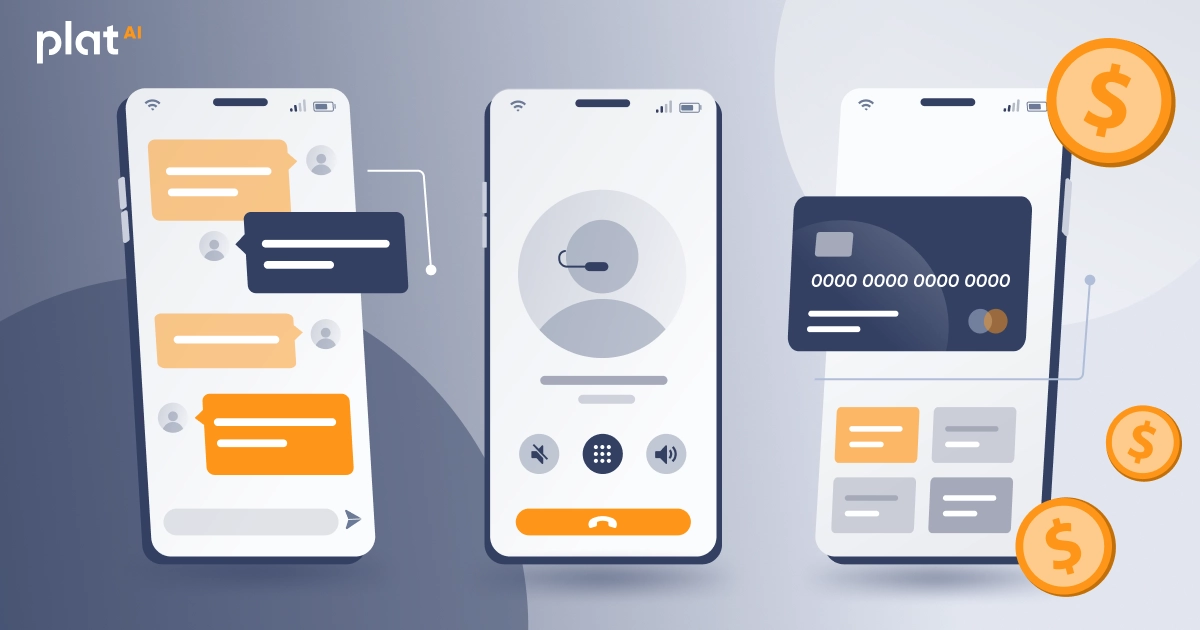Banking Bot: What Is It?
Banks stepped into the AI world decades ago, but one of their most prominent technological advancements is the banking bot. Following some of the hottest AI trends for business owners, more than 16% of banks currently use bots. This helps them cut costs, improve the customer experience, and handle thousands of customer interactions simultaneously.

A bot is an AI-powered interface that can interact with customers, analyze their queries, and perform tasks accordingly. For instance, banks and credit unions employ bots to automate many of their business processes, namely repetitive tasks, such as answering the same customer queries and performing money transfers.
If you want to learn more about how banks utilize AI bots, continue reading this article.
Types of Bank Bots
Banking bots can be categorized into two groups based on how they are built:
Rule-Based Bots
Also known as “scripted” bots, these virtual assistants are programmed to respond to specific keywords and commands. Developers build a decision tree with a hierarchy of questions and answers the user may have. When the user answers “Yes” to the bot’s question, the bot will pose the following question until the user finds the answer they were looking for. One drawback of a scripted bot is that the number of questions it can answer is limited. This is because it is only programmed to respond to specific questions with predefined answers. As such, the chatbot may only address the customer’s query if the right keyword or phrase is inputted.
AI-Based Bots
These bots are more sophisticated, as they depend on artificial intelligence. Some bots can also learn on machine learning and Natural Language Processing (NLP) algorithms, which are commonly used in language learning with AI. ML- and NLP-driven models are built and trained on historical data and previous interactions. Later, these models are trained to answer queries without human involvement. As a result, NLP-driven bots can analyze and prioritize questions depending on their complexity or urgency. For instance, an AI-powered bot may receive hundreds of requests, rank them from most urgent to least, and analyze past interactions to provide the most appropriate response.
Uses of Chatbots in Banks
The rise of online banking and improvements in efficiency and customer service drove banks to adopt personalized chatbots. Examples include Amy from HSBC, Erica from Bank of America, Ally Assist from Ally Bank, and so on. These AI bots can perform the following complex tasks:
Transfer Money, Buy Stocks, and Mutual Funds
First, chatbots can be trained to transfer and receive money autonomously. At any time, the customer may request to send money securely, cancel transactions, and even pay off credit cards with just one click. Banks also deploy trading bots that can make investment decisions, including buying and selling stocks in response to market changes.
Review and Customize Accounts
Users can also monitor their available balance and spending habits with the help of an AI banking bot. Moreover, a banking bot can also analyze historical spending and give budgeting recommendations. For instance, an AI-powered platform can update you on your daily spending in real-time and send notifications such as “you’ve spent more today than yesterday” or “you’ve exceeded your average monthly spending this month.”
Respond to FAQs
AI chatbots’ most prominent use case is acting as a customer support agent. These bots help save customer support agents time answering general questions and allow them to concentrate on more complex tasks. In fact, about 90% of all customer queries can be handled by a banking bot. For example, a customer may type, “How can I apply for a personal loan?” The AI agent can instantly respond with all the necessary information. A banking bot can improve customer experience by providing almost instant responses.
Provide Location – Based Answers
These bots go a step further and answer questions depending on the customer’s location. For instance, you can ask the bot, “Where is the nearest ATM?” and it will give you the precise location and the cash status of the closest ATM using GPS.
Push Notifications
Banking bots can be trained to send important reminders to users, including notifications about due payments and documents for loan application processing. As a result, AI automation cuts manual labor, saving employees time by handling menial tasks, such as processing paperwork. It can also enhance the customer experience by ensuring all documents are uploaded and provided in advance, saving them the hassle of processing delays.
Receive Fraud and Suspicious Activity Alerts
Finally, AI-powered bots can help protect your account from fraud and dubious transactions. For example, if the user types “I noticed suspicious activity on my account” into the chat box, the bot may immediately flag the transaction and report it to the bank upon a quick verification process.
Benefits of Chatbots for Banking
AI chatbots offer various advantages to banking institutions. Some of these benefits include:
- Round-the-Clock Support – Chatbots provide 24/7 customer support to users. NLP and machine learning technologies allow them to handle thousands of customer queries instantly and simultaneously.
- Improved Customer Experience – Most banking bots address customers by their preferred name and language. This personalized approach transforms the customer experience and boosts satisfaction.
- Reduced Staffing Needs – AI bots can complete tasks 20 times faster than humans. Chatbots are projected to save businesses more than 2.5 billion working hours. Therefore, banks can save money on hiring extra staff for repetitive tasks and give customer agents the opportunity to focus on more complex tasks.
- Reduced Costs – Last but not least, AI bots in banking can significantly lower operational costs. Bots are estimated to save banks around $8 billion yearly. Even though there are still costs associated with implementing the software, such as paying for developers, a banking bot can cost significantly less than hiring extra staff in the long run. The AI models that power chatbots also have relatively low maintenance costs.
Sum Up
Bots are becoming an integral part of most banks. This is because they can perform menial and repetitive tasks much faster and more efficiently. As a result, conversational AI is revolutionizing the banking industry, facilitating customer experience and engagement, and saving the banks plenty of time and money on repetitive manual tasks.
Try our real-time predictive modeling engine and create your first custom model in five minutes – no coding necessary!
- Fully operational AI with automated model building and deployment
- Data preprocessing and analysis tools
- Custom modeling solutions
- Actionable analytics
- A personalized approach to real-time decision making



